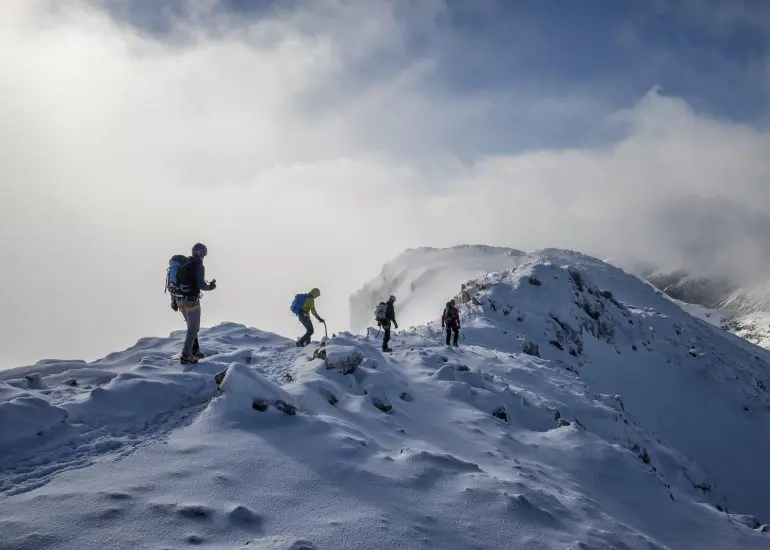Mountaineering is the sport of climbing mountains. It requires a high level of physical fitness as well as mental endurance. Mountaineers must be able to overcome difficult obstacles and often face treacherous conditions.
The sport of mountaineering has a long history, dating back to the early days of exploration. Mountain climbing was often used as a way to reach inaccessible areas and to gain a vantage point for surveying the surrounding land. In recent years, mountaineering has become more popular as a recreational activity, with people of all ages and abilities enjoying the challenge of scaling a mountain.
So, what is mountaineering? Starting with the history of mountaineering up to the present day, read on to have mountaineering explained from foot to summit.
The History of Mountaineering

A helping hand while mountaineering (Photo: David Trood via Getty Images)
The history of mountaineering is not especially long. Whilst people have climbed mountains for centuries, this was historically done for pragmatic reasons such as to gain an understanding of surrounding topography. In terms of summiting as a goal, one of the earliest accounts occurred in 1760 when scientist Horace-Bénédict de Saussure announced a reward for whoever reached the peak of Europe’s highest mountain, Chamonix. This would only be claimed in 1786.
The golden age in the history of mountaineering can be said to have begun in the mid-19th century. Things moved quickly and between 1850 and 1870, climbers had scaled all the top peaks in the Alps. The 1950s meanwhile was all about the Himalayas. On 29 May 1953, a team became the first to successfully summit the highest mountain in the world, Mount Everest – though mystery remains as to whether previous attempts succeeded.
Over time, the style and aims of mountaineering shifted. The 1960s saw expedition style mountaineering give way to more in the “alpine” style. We’ll shortly explore this in more detail in the “what is alpine mountaineering” section. First, an overview.
Mountaineering Explained: What is Mountaineering?

Mountaineering in the snow (Photo: Westend61 via Getty Images)
Mountaineering, also called mountain climbing or alpinism, is the sport or pastime of climbing and exploring mountains or mountainous terrains. There is no overarching goal in mountaineering. While some do aim for particular heights or summits, others do it for the sheer challenge. For safety reasons, mountaineering is a group activity.
Whilst this may seem relatively clearcut, there are two main sources of ambiguity. Firstly, there is no geological delineation of the word “mountain” beyond that of a landmass that rises abruptly and generally has steep slopes. There is, for instance, no minimal height for a mountain as opposed to, say, a hill. Secondly, mountaineering lacks the formal rules or competitions normally associated with a sport. There are tangential sporting events such as the Ice Climbing World Cup, but nothing directly equivalent.
Nevertheless, mountaineering does require significant technical skill, including hiking, rock climbing and proficiency in snow and ice. There is a general assumption that, to be considered as mountaineering, the terrain and/or conditions must present a level of challenge that requires previous experience and learned skill.
Mountaineering also has a governing body, Union Internationale des Associations d’Alpinisme (UIAA), and is recognised as a sport by the International Olympic Committee. On a wider scale, there are many mountaineering clubs, such as the British-based Alpine Club.
Alpine Mountaineering vs Expedition Mountaineering

A expedition to the peak of the mountains (Photo: © Marco Bottigelli via Getty Images)
The two main types of mountain climbing, known as expedition style and alpine style, are intrinsically linked to the history of mountaineering. Most if not all early mountaineering was done in the expedition style. Today, alpine mountaineering dominates. So, what is alpine mountaineering versus expedition mountaineering?
One of the defining differences between expeditions and alpine style mountaineering is the type of climb for which they are designed. Whilst expeditions developed at a time when most summits were remote and hard to reach, the alpine style reflects the increasing accessibility of mountains.
What is Expedition Mountaineering?
Overall, expedition-style mountaineering is about scaling massive summits and long distances requiring huge quantities of gear. It’s typically done on taller peaks and involves setting up basecamp at the foot of the mountain. From there, climbers might make a series of ascent and descent trips up and down the mountain to transport their supplies and/or take breaks along the way to rest and acclimatise to the altitude. This style is generally done in larger teams and can take several days or even weeks to complete.
What is Alpine Mountaineering?
By contrast, in terms of “what is alpine mountaineering”, it is a more lightweight and efficient form typically done on shorter to medium-sized mountains within reach of civilization. It involves climbing from the base to the summit in one continuous push carrying only the essentials. This style is often done in pairs or in small teams and can take anywhere from a few hours to a few days.
And that is mountaineering explained in a nutshell. From “what is mountaineering” to “what is alpine mountaineering”.











